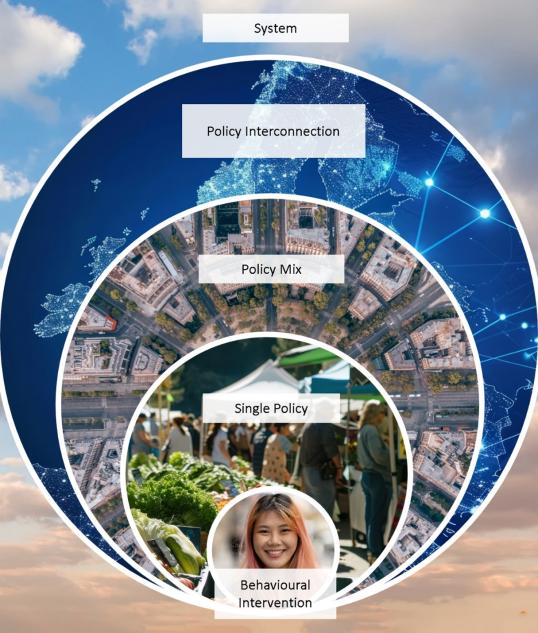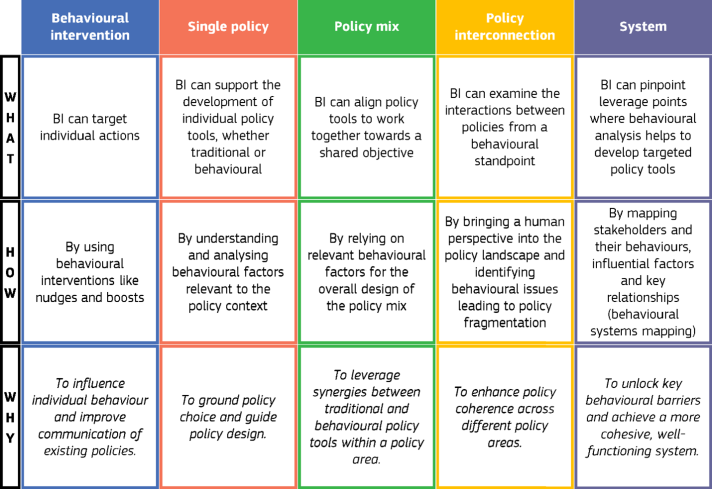
Why Behavioural Insights are more relevant than ever
The crises and challenges we are facing are increasingly multi-faceted and complex: climate change, energy scarcity, social inequality, to name but a few. One major thing they all have in common is human behaviour.
Complex (or ‘wicked’) problems require adaptive solutions. Traditional policy approaches can miss important aspects and interlinkages, especially when it comes to the intricate web of human behaviour and the systemic interactions that underpin the biggest challenges of our time. By failing to address the variables of human behaviour, the effectiveness of policies can also be reduced.
This is where Behavioural insights (BI) come in: to bridge this gap and uncover behavioural interlinkages often not considered in policy.
You’ve certainly heard about nudges—those behavioural interventions that subtly shape the choice environment to encourage better decisions at little to no cost. A typical example is placing healthy snacks at eye level in a cafeteria, which makes people more likely to choose them, but still free to opt for junk food. But did you know they represent only a fraction of what BI can offer? The real power of BI goes beyond isolated behaviour change interventions.
BI can help to design policies that foster systemic change and reshape entire systems, from crisis preparedness to biodiversity conservation. When integrated early and thoughtfully into policy design, BI can amplify the impact of traditional policies, fostering long-term change. Our latest report highlights the transformative potential of integrating BI from the outset of the policymaking cycle, ensuring coherence and maximising impact.
How BI can intervene in policymaking
While BI is best known for approaches such as nudging, which focus on specific behaviour change interventions in a narrow (policy implementation) context, they can be used and lead to changes in much wider and multiple policy scopes:
Behavioural interventions: Small changes in individual behaviour can ripple outwards, triggering broader societal shifts. For example, a nutrition label on food products can encourage demand by consumers for healthier products. This, in turn can trigger a healthier reformulation of products by producers, thereby benefitting all consumers, including those not initially sensitive to the health aspects of food. However, predicting these cascade effects isn’t always straightforward.
Single policies: Bringing BI early into the policy process can ensure that both behavioural interventions and traditional policy tools are designed with a solid understanding of human behaviour, making them more effective. For example, behavioural scientists informed the EU Consumer Rights Directive by advocating for banning pre-ticked boxes in online supplementary services, such as insurance add-ons for flights. The goal was to prevent companies from exploiting consumer inattention.
Policy mixes: Policies rarely work in isolation. BI can improve how different policy tools fit together, ensuring they reinforce rather than contradict each other. Whether policies use regulations, incentives, or behavioural interventions, BI helps align them with how people actually think and act. For example, energy consumption taxes could be informed by surveys of their acceptability among the population and designed to leverage loss aversion. They could then be combined with a nudge providing real-time feedback on electricity use to target people’s motivation.
Policy interconnection: Policies in different areas often affect the same people in unexpected ways. Taking their perspective helps uncover these hidden interactions, making policies more coherent and reducing unintended consequences. For example, adopting a farmer's perspective can help to identify potential overlaps or contradictions between the environmental, health, and agricultural policy signals they receive.
System: People don’t make decisions in a vacuum. BI can help map out key stakeholders, their behaviours, and the influences around them to pinpoint where behavioural barriers exist. This helps policymakers target the right levers for change and design more effective interventions. A case in point: a behavioural systems map for retrofitting homes in Wales revealed the need for targeted interventions to align stakeholder incentives.
Looking ahead: the future of BI in policymaking
In an ideal – and hopefully not so distant - world, every policy would be designed with a deep understanding of human behaviour. From the very start of policy discussions, behavioural scientists would work alongside experts in the broader system, helping to define the problem, shape policy options that account for real-world behaviours, and test their effectiveness before implementation. They would anticipate public reactions, support Member States in rolling out policies, and evaluate their impact to refine future approaches. At every stage of the policy cycle, targeted and behaviourally informed communication would ensure that citizens, stakeholders, and policymakers are engaged and responsive.
While this vision is not yet fully realised, progress is underway. The European Commission has long recognised the potential of BI, incorporating it into policymaking through initiatives like the Competence Centre on Behavioural Insights and its inclusion in the Better Regulation Toolbox. These are important steps, but we can do better. Right now, BI is mostly confined to evaluating policy options rather than shaping them from the outset. This means behavioural considerations often come too late in the process, leaving policies vulnerable to unintended effects that could undermine their success.
So, how can we change this? How can BI contribute to systemic change more systematically?
A big part of the answer lies in combining BI with other disciplines something we are doing in the EU Policy Lab – together with the strategic foresight and design for policy teams, a cross-cutting approach which can take policymaking to the next level. This interdisciplinarity enables policymakers to craft tools that align with both systemic drivers and human nature, leading to more cohesive and effective policies. The EU Policy Lab is about to develop such a behavioural systems approach with a project on EU green policy implementation. Take a peek!
There is a lot of unused potential. So how can we further integrate BI into policymaking to tackle today’s pressing challenges?
Join us in rethinking the role BI plays in policymaking and follow the discussion on LinkedIn.
Details
- Publication date
- 7 February 2025
- Author
- Joint Research Centre
- EU Policy Lab tags





